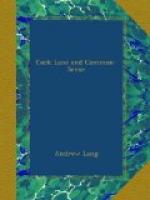{30} Teutonic Mythology, English translation, vol. ii. p. 514. He cites Pertz, i. 372.
{31} A very early turning table, of 1170, is quoted from Giraldus Cambrensis by Dean Stanley in his Canterbury Memorials, p. 103. The table threw off the weapons of Becket’s murderers. This was at South Malling. See the original in Wharton’s Anglia Sacra, ii. 425.
{35} See Mr. Tylor’s Primitive Culture, chap, xi., for the best statement of the theory.
{38} Petitot, Traditions Indiennes du Canada Nord-Ouest, p. 434.
{40} Very possibly the whirring roar of the turndun, or [Greek], in Greek, Zuni, Yoruba, Australian, Maori and South African mysteries is connected with this belief in a whirring sound caused by spirits. See Custom and Myth.
{41a} Proc. S. P. R., xix. 180.
{41b} Brough Smyth, i. 475.
{42} Auckland, 1863, ch. x.
{45a} [Greek].—Iamblichus.
{45b} Kohl, Kitchi-Gami, p. 278.
{48} Hind’s Explorations in Labrador, ii. 102.
{50a} Rowley, Universities’ Mission to Central Africa, p. 217: cited by Mr. Tylor.
{50b} Quoted in La Table Parlante, a French serial, No. I, p. 6.
{51} Colonel A. B. Ellis, in his work on the Yorubas (1894), reports singular motions of a large wooden cylinder. It is used in ordeals.
{52} The Natural and Morall History of the East and West Indies, p. 566, London, 1604.
{53} February 9, 1872. Quoted by Mr. Tylor, in Primitive Culture, ii. 39, 1873.
{57} Revue des Deux Mondes, 1856, tome i. p. 853.
{60} Hallucinations, English translation, p. 182, London, 1859.
{62} Laws, xi.
{63} Records of the Past, iv. 134-136.
{65a} The references are to Parthey’s edition, Berlin, 1857.
{65b} [Greek], 4, 3.
{65c} All are, for Porphyry, ‘phantasmogenetic agencies’.
{66a} Jean Brehal, par P.P. Belon et Balme, Paris, s.a., p. 105.
{66b} Proces de Condemnation, i. 75.
{67a} Appended to Beaumont’s work on Spirits, 1705.
{67b} See Mr. Lillie’s Modern Mystics, and, better, Mr. Myers, in Proceedings S. P. R., Jan., 1894.
{68a} Origen, or whoever wrote the Philosophoumena, gives a recipe for producing a luminous figure on a wall. For moving lights, he suggests attaching lighted tow to a bird, and letting it loose. Maury translates the passages in La Magie, pp. 58-59. Spiritualists, of course, will allege that the world-wide theory of spectral lights is based on fact, and that the hallucinations are not begotten by subjective conditions, but by a genuine ‘phantasmogenetic agency’. Two men of science, Baron Schrenk-Notzing, and Dr. Gibotteau, vouch for illusions of light accompanying attempts by living agents to transfer a hallucinatory vision of themselves to persons at a distance (Journal S. P. R., iii. 307; Proceedings, viii. 467). It will be asserted by spiritualists that disembodied agencies produce the same effect in a higher degree.




